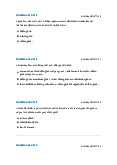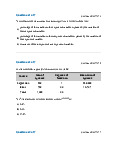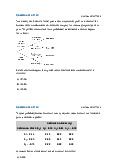




Preview text:
IOSR Journal of Business and Management (IOSR-JBM)
e-ISSN: 2278-487X, p-ISSN: 2319-7668. Volume 16, Issue 12.Ver.II (Dec. 2014), PP 39-43 www.iosrjournals.org
Talent Acquisition a Key Factor to Overcome New Age
Challenges and Opportunities for Human Resource Management Mr. Shyamasundar Tripathy
Management Faculty (PG Dept.) Institute of Professional Studies and Research, Cuttack, Odisha, India
Abstract: One of the most surprising outcomes of the 2007-2009 recessions is that talent acquisition —
particularly top talent — is actually harder, not easier, than before the downturn. Despite the fact many well-
respected, out-of-work executives are clamoring to get back in the game, surveys show companies are failing to
find the right talent to fill reinstated positions. In a recent study by the Corporate Leadership Council, 72
percent of companies predict they will have a large number of leadership vacancies over the next three to five
years. Even more surprising, 76 percent said they are “less than confident” in their abilities to adequately staff
these positions. This phenomenon is worldwide. The chief executive of global recruitment agency Manpower
recently told the World Economic Forum that 30 percent of companies across the globe continue to struggle to
fill available positions. Global searches confirm the increased difficulty getting candidate‟s attention. The
situation is pervasive and clearly a result of a miserable economy, high unemployment and a rampant sense of
anxiety and insecurity among the well-employed executives. The “Dot Com” era was tough but this is an even
tougher time! There are several reasons why companies are struggling to fill their empty positions. In addition
to the impact of retiring Baby-Boomer executives and the lack of qualified replacements ready to assume
strategic positions and the role of HR department also more important to overcome this talent gap in the organization
Key words: Downturn, Reinstated positions, „Dot Com” era, Baby-Boomer executives, Talent gap I. Introduction
A strategic approach to identify, attract and onboard top talent into the organization, the Talent
Acquisition process has evolved a lot in the past decade. As the business gets more dynamic & complex and
talent becomes short in supply, what will differentiate the leader from the rest of the pack will be their ability to
draw top talent. The talent hunting will focus on how companies are redrawing their talent strategies in the new HRD era
This paper aim to create a platform for discussion around innovations in talent acquisition in the
context of the present agile and global workforce. It will showcase new practices that have evolved to cope with
the new and changing talent sourcing challenges as it effectively contributes to business strategy. II. Objective
To exchange new-age practices in talent acquisition – methods and new learning on what the best in the
industry are doing to meet their talent challenges.
Additionally sensitize Talent and HR Managers on the challenges and opportunities in the talent market to
optimize it as a business driver.
A focused and differentiating approach towards talent acquisition and its subsequent management is critical
for continuous business growth.
To focuses on the trends and best practices in the recruitment function and will be beneficial for HR heads,
Recruitment, TA and HR professionals across industries. III.
The New Talent Acquisition Edges
Remember when HR was referred to as the personnel department? It was non-strategic and highly
tactical – little more than hiring employees, administering benefits, tracking attendance and handling employee
issues. Today HR is a considered a core business function and talent acquisition was referred to as the
recruiting department – with no more responsibility than reviewing resumes, screening candidates, and
organizing candidate interviews. The phrase ―talent acquisition‖ is now mainstream – and is embraced by both
large and small organizations. Companies understand that there is a broad end-to-end focus needed; one which
stretches from building a strategic employment brand, through sourcing and recruiting, all the way to on
boarding top people. Recruitment is an essential element of talent acquisition (and includes sourcing, selecting,
hiring and on boarding), but it is one of many processes that fall under this highly complex talent area, including:
www.iosrjournals.org 39 | Page
Talent Acquisition a Key Factor to Overcome New Age Challenges and Opportunities for … Planning and Strategizing Segmenting the Workforce
Creating, Validating and Maintaining an Employment Brand
Delineating Candidate Audiences
Managing and Cultivating Candidate Relationships
Defining Metrics and Conducting Analysis
Creating an Organizational Recruiting Culture
Within each of these core elements of talent acquisition are many other sub-activities and best
practices. And, of course, the selection of tools, technology and outsourcing partners is a key element of a
company’s talent acquisition strategy. Best-practice organizations are focusing on strategic areas (such as
employment branding, social networking, candidate relationship management and key analytics) and have
tightly integrated talent acquisition with talent management – organizationally, systemically and technologically. IV.
Strategies Tool For New Age Talent Acquisition
Now each organization focused on finding, developing and keeping highly talented people in their
teams and organizations excel above the competition. Effective leaders know that a key competitive
differentiator today is in innovative, critical thinking, prudent risk-taking, and ambitious talent. The constant ebb
and flow of the current economic tide makes it is increasingly important for leaders to identify retain and
advance top talent to ensure they have the right people, at the right time in the right positions. In other words,
that there is alignment between leadership, business strategy, talent development and succession planning.
Here are six strategies you can employ to gain a talent advantage.
1. Create a charismatic culture that pulls in highly skilled and talented people
Nothing attracts top talent to an organization like top talent. That is an immutable organizational fact.
There is a charismatic culture that attracts extraordinary talent and it starts with leaders. While running a small
organization never left the hiring, managing or promoting of talent to anyone else. This is a key responsibility in
building the best team in the marketplace and built the company brand and company people brand to such a
positive level that the company was very attractive to top talent, to the extent of having the pick of the crop. Top
talent is attracted to strong corporate brands but in the end it's the people they work with who are the ultimate magnets.
2. Build a sticky culture that adheres extraordinary talent
Top talent wants to be challenged and recognized (some desire public accolades others prefer private
rewards.) Ensure that your organization offers emerging leaders challenges and exceptional learning
opportunities for professional and personal growth. Review training programs for relevance and create fulfilling
experiences for top talent by engaging in a regular dialogue to evaluate their level of engagement. Would you
describe your culture as a glue stick, epoxy or crazy glue?
3. Build a Social –Media framework for talent acquisition
Social media doesn’t need to be the absolute center of your recruitment strategy, but it would be ill-
advised to ignore the trend completely. Factors like personal, transparent, social marketing and more sharing
are changing and advancing the ways of approach finding the best talent and taking it to a more personal, open
and collaborative experience. Employees on Twitter, LinkedIn, and Facebook are contributing to the efforts of
recruiting through their own posts and tweets. Not only are open positions getting distributed as pieces of
content to vast networks of people, but it’s also facilitating the use of social referrals — one of the best sources
of quality candidates. Job seekers are finding ways to take advantage of social referrals by keeping in contact
and engaging with key members of companies.
4. Implement rising stars as a goodwill builders for referral program
The brightest and the best people know others just like them. Some of the most talented team members
sourced came from referrals from existing staff. If you do step one and two above with aplomb the referrals will
naturally come. To expedite the process, you can make it formal by communicating to your top talent that you
are looking for similar folks and reward them in some fashion for bringing good people to the table. No amount
of advertising can compete with rising star word-of-mouth.
www.iosrjournals.org 40 | Page
Talent Acquisition a Key Factor to Overcome New Age Challenges and Opportunities for …
5. Communicate your organization's career development programs
Don't keep your robust career growth opportunities a secret. It never ceases to amaze me how many
talented folks in organizations are unaware of the plethora of programs and policies available to them.
Oftentimes, these are terrific attraction, retention and advancement tools that go unnoticed and unused. Use all
your communication channels - website, company bulletin boards, and intranet, and employee handbook,
newsletters - to optimize awareness of your talent development opportunities internally and externally.
6. Annually assess top performers for future potential
As Marshall Goldsmith has eloquently said: "What got you're here won't get you there." It is important
not to confuse high performance with high potential. The high performance moniker is often bestowed as a
result of an employee's contribution in a current role; this is no guarantee of future potential. In fact, recent
research suggests that more than 70% of today's top performers are not high potentials. They may have what it
takes now to succeed, but are missing the integral attributes required for future roles. V.
Implement Talent Acquisition Strategies To Meet Business Need
When companies complain that they can't find enough good people, the cause, in our view, is most
likely to be deep-rooted and centered on a misalignment between the strategic goals of the business and the
efforts of the company's talent acquisition professionals. Long term business plans must be flexible – they need
to change when the circumstances that gave rise to them change. If there is a fundamental change in direction or
focus, everything else must be reviewed and where necessary adapted or even redesigned to reflect the change.
Too often, the talent acquisition plan gets overlooked, or cannot flex quickly enough, and the result is the
business begins to fall behind competitors in the 'war for talent. Designing the talent acquisition strategy is a
critical first step in allowing leaders in the HR function to get that crucial alignment. These are the key, seven
steps we followed and can be used as a template for your own efforts:
1. Look at the key skills required to ensure business objectives are continuously met, and regularly review them.
As the pharmaceutical industry evolves so do the skills required within any business. Companies work
in a variety of therapy areas which often change, therefore the required specific therapy expertise can also vary.
You don't want to be hiring 'key' people only to see their expertise become redundant within a matter of months.
2. Do a skills gap analysis to show where you are exposed.
As the business portfolio evolves there is often a need to bring new skills, techniques or areas of
expertise into the organization. Identifying those gaps early is vital. It helps HR professionals map the market to
determine where that talent currently sits, how big a potential candidate pool there is and where the potential
obstacles might arise, e.g. location.
3. Develop an internal mobility and succession plan to ensure good people are being utilised optimally.
Having a succession plan in place is a crucial component to any company's workforce plan. It not only
acts as a great motivator with existing key people but also acts as a retention tool. 4. Plan for attrition.
Again, this is a very important element in workforce analytics for presenting to business leaders. By
forecasting future leavers it helps leaders plan accordingly for any skills gaps and back-fill appropriately, and in good time.
5. Analyze company demographics to ensure diversity objectives are met.
Diversity is no longer optional. It has become absolutely essential within any business as, in our
opinion, it drives creativity and innovation. From gender to ethnicity, it is important to get the balance right.
One of the biggest problems in almost all industries is that women in senior leadership roles remain rare. At
Pfizer, although we always chose the best person for the job, we made a concerted effort to ensure diverse
candidate short lists were always provided to hiring teams.
6. Determine gaps and therefore external recruitment needs.
Once the internal skills have been identified and succession planning has been implemented, any clear
gaps can be determined; what's going to be critical in the near future and what's needed for the longer term.
www.iosrjournals.org 41 | Page
Talent Acquisition a Key Factor to Overcome New Age Challenges and Opportunities for …
7. Define and develop an external sourcing strategy.
Strategies and tactics used to recruit active jobseekers are quite different to those used for 'passive
candidates'. These are people who are currently quite happy where they are working but might be open to the
idea of a move – if it's the right one, proposed and presented well. In the past, when companies were operating
in a comparatively 'steady state', a big corporate brand was often enough to produce a good candidate roster.
Today, corporate brands have a limited shelf life and should not be over-relied on. Only a compelling,
personalized and value-led employment proposition will attract the best people. VI.
Talent Acquisition Intricacy
It’s harder to identify talent — to separate the wheat from the shaft.
With so many talented executives sidelined during the recession, one would think it would be easy to
post an ad and bring in a plethora of good candidates. Not so. In fact, the task of identifying the right talent for
open positions has become more and more daunting. It’s a little like looking for the proverbial needle in the
haystack. If you want to find that unique individual with the perfect experience, background and management
style to fill your position, you better have strong market intelligence and a compelling story to tell candidates.
Your recruiters must know everything about the position and come from a place of credibility. The ―gates‖ are
more heavily guarded now than ever before as candidates have their guards up and are less motivated to think about moving.
It takes twice as much effort to attract the right candidate.
After recession the qualified candidates are more cynical and skeptical – and afraid. Therefore they are
harder to attract and entice. For example, if a prime candidate is currently employed, it may take you twice as
long to get his or her attention, let alone convince him or her to walk away from a secure gig to look at your
opportunity. Most employed executives are keeping their heads down and their noses to the grindstone.
Candidates believe venturing into the great unknown in a volatile market makes far less sense then staying in a familiar surprise-free job.
It takes more creativity and flexibility to land the necessary talent.
Now companies with open positions do not have the upper hand in the negotiating part of the executive
search game. Wages are starting to spike up again as competitive companies begin looking for similar talent.
What’s more, if prospects feel poorly treated or short-changed on compensation and benefits packages, and
consequently walk away from the opportunity, the company’s reputation can take a hit in the marketplace. This
will make hiring good talent now as well as in the future harder and harder. The ability of individuals to share
their negative reactions via Twitter, Facebook, eBoss, BadCompany and other social media should give
companies enough reason to create positive experiences with every potential candidate, even those they know
they don’t want to hire from the onset.
People are redefining and reposition their experience
In order to compete in the race and be attractive to more companies. What they are doing, in many
cases, is recreating and repositioning their history to be more generally applicable to a broader range of job
specifications. As hiring companies get more focused on finding the right fit for their new strategic plan or top-
level replacement, individuals are presenting their backgrounds with broader and more general strokes. This
compounds the problem of matchmaking.
Technology revolution: All of a sudden, everyone is a ―digital expert‖
Talking about cloud computing and content – terms one should really never use because of their
ambiguity. So sifting through well-written ―marketing collateral,‖ – the new term for ―resume‖ — takes more
time, a keen eye and, ultimately, a face-to-face meeting to sort fiction from reality. VII.
Talent & Performance Management
Talent Development Strategies develops integrated talent reviews, succession planning and other talent
management initiatives that drive business results and are critical to business strategy. So a comprehensive
performance management programs ideally required to meet company's objectives and create a high-
performance culture. Finally, a rigorous promotion processes to help identify the cadre of leaders with the
potential to succeed into more senior roles within the company.
Talent Assessment and Review –focus on business-related talent challenges, identify key talent and implement
key development initiatives to retain them.
Succession Planning –identify critical jobs and successors to fill those jobs and assume key leadership positions within your firm.
Talent Development –retain key talent by focusing on specific development activities for your employees.
Performance Management Process – develop an efficient, yet rigorous performance management process that
fits your business strategy to achieve key goals.
www.iosrjournals.org 42 | Page
Talent Acquisition a Key Factor to Overcome New Age Challenges and Opportunities for …
Performance Appraisals - create specific job-related competencies and performance appraisals tailored to jobs in your organization.
Performance Management Coaching – provide customized coaching to help leaders have effective
performance discussions with direct reports.
Promotion Process – develop and implement comprehensive promotion processes to ensure that the right
people are selected for the next level of leadership. VIII. Conclusion
Thoughtful organizations and leaders build strategy around acquiring talent to meet both current and
future business needs. Before adding staff or simply filling a vacant position, it is important to have clear sense
of the ―gaps‖ as they relate to the skill sets needed to meet current and future performance
requirements. Otherwise, you are simply adding people that may or may not contribute to the organization’s
success. Once a gap analysis has been conducted and managers have a good sense of their staffing needs
including the availability of talent, they are in a position to execute on a plan to acquire the needed skills and
talent. Often organizations will use more than one method (e.g. recruiting, sourcing, training &
development).Whether acquiring outside talent or developing talent from within the organization, ideally,
managers should be building a network or ―hot file‖ of candidates to draw from when the need
arises. Recruiting and sourcing can certainly be outsourced to staffing & recruitment agencies, allowing
businesses to focus more time on core competencies. With that said, good managers assume accountability for
actively growing and developing their own people – regardless of whether they use outside services to recruit or
source candidates. The new talent paradigm requires the dynamic integration of HR and diversity strategy to
optimize and unleash the creativity and innovation of a diverse and talented workforce..A clear business case for
integrated HR/diversity efforts has not been articulated. While experts understand the need new talent paradigm
calls for an active link between HR and diversity in articulating the need of business. Reference Journal Papers [1].
Bersin by Deloitte ..― Talent Management Framework‖ In 2006 [2].
Finders Keepers: ―Five Strategies to Attract and Retain Extraordinary Talent‖ By: Lisa Martin, Lisa Martin International [3].
An Oracle White Paper June 2012 ―The Future of Talent Management: Four Stages of Evolution‖ [4].
SHRM: Improving Talent Management Strategies, 2/22/2013 Books [5].
Lance A. Berger and Dorothy R. Berger: The Talent Management Handbook page- 3-10 [6].
Ryan Estis: ―Trends in Talent Management‖ page- 8-14 [7].
McKinsey: ―Talent management strategy‖ page- 168-172 [8].
The Future of Talent Management: Four Stages of Evolution page-115-116 Proceedings Papers: [9].
Sajjad Masud: 5 Ways Social Media Is Revolutionizing Talent Acquisition [10].
Suzi Alligood & Gina Todd: The Talent Challenge [11].
Tom Bradley and Christian Steele: Design and implement talent acquisition strategies to meet corporate goals [12].
Barry Shulman: Talent acquisition is surprisingly harder in this new era [13].
Amy Van Ditti Xenium: Training for Talent — Manage, Motivate and Measure [14].
Thought Leadership :The New Talent Management Paradigm Thought Leadership [15].
Edna Chun and Alvin Evans : Integrating HR and Diversity Strategy
www.iosrjournals.org 43 | Page




